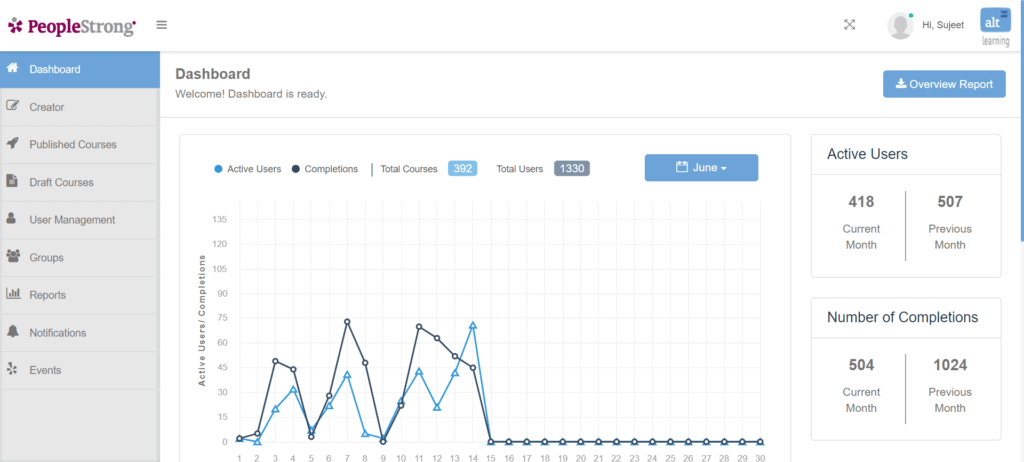What if we train them and they leave? What if we don’t and they stay?
This is a common phrase whenever discussion surrounds training. Or in today’s context, better known as learning & development.
In a research paper by Dr Amir Elnaga & Amen Imran titled ‘The Effect of Training on Employee Performance’, it affirmed the proposition that training has a positive impact on employee performance.
And that is one of the key reason in the adoption rate of the Learning Management System.
What is LMS?
According to Wikipedia, A learning management system (LMS) is a software application for the administration, documentation, tracking, reporting, and delivery of educational courses, training programs, or learning and development programs.
The learning management system concept emerged directly from e-Learning.
Although the first LMS appeared in the higher education sector, the majority of the LMSs today focus on the corporate market.
Exponential LMS adoption growth
In Asia alone, it had witnessed a 17.3 per cent growth rate with vendor revenues reaching $5.2 billion in 2011 and doubled to $11.5 billion by 2016.
According to a Markets and Markets report: “APAC organizations are increasingly opting for LMS to gain better returns on investments made on talent development, employee learning requirements, proper employee training, and receiving quantifiable business outcomes.
As many organizations have tight learning budgets, they prefer a technology-enabled learning approach, which is also a cost-effective way to offer training and resources to their learners. This enables high growth opportunities in this region.”
Why Are Organisation Adopting LMS?
It really depends on each organisation’s training objectives and outcomes but the most common reason is to ramp up training sessions and to track the desired outcomes.
Traditionally training is event based.
For logistical and financial sense, it would encompass downtime from your employees and session would last the availability of venue which can be anything between half a day to three days.
End of the day, employers are looking for measurable learning outcomes.
The classroom-style approach may work for young learners, but adults learn differently.
Most importantly, it takes a lot more than a single event to change a person’s behaviour.
This and the high price tag of event-based training motivates organisations to explore the digital alternative which drives the adoption.
Key Benefits
1. Organizes And Safely Stores Big Data
Learning Management Systems allow you to gather all Big Data in one location. This also makes it easier to maintain and update your learning materials.
In addition, most LMSs feature advanced encryption so that you don’t have to worry about data falling into the wrong hands.
2. Monitors Learner Progress And Performance
Virtually all LMS platforms feature built-in reporting and analytics. Thus, you’re able to track various aspects of your online training program.

If the Learning Management System lacks sufficient reporting capabilities, you can typically purchase add-ons or plug-ins to boost its functionality.
You can track everything from learner engagement to eLearning assessment results.
This means that you can identify patterns and trends, especially since many LMSs provide data visualizations, such as graphs and charts.
3. Improves Resource Allocation
There are a number of ways that LMS platforms can help you allocate online training resources more effectively.
First and foremost, you can identify aspects of your online training program that aren’t meeting expectations.
Low learner engagement is usually an indicator that you need to reevaluate an online training module or activity.
Secondly, Learning Management Systems help your eLearning team update online training assets more rapidly.
Then there’s the matter of deploying online training resources on a global scale. Thus, you have the power to keep corporate learners up to date using a single tool.
4. Personalizes The Online Training Experience
You can assign different learning paths or online training resources for individual corporate learners with the help of an LMS.
Therefore, everyone gets the individualized online training they need based on their learning goals, job duties, and various other criteria.
There’s even the option to unlock the navigation so that corporate learners can choose their own online training activities and coursework.
All this translates into more effective online training experiences and increased learner satisfaction. Not to mention, improved memory retention and engagement.
5. Improves eLearning Accessibility
Modern learners expect online training resources on demand.
After all, we live in the digital age, where information is always at our fingertips, thanks to smartphones and wearable tech.
Learning Management Systems allow you to deploy and track online training courses without geographical limitations.
So long as they can log in to the system, corporate learners have the opportunity to expand their knowledge and hone skills.
Alt Learning
And that forms the premise of PeopleStrong’s LMS – Alt Learning.
A mobile-first LMS, it has a total of 100K+ active users that collectively have clocked more than 1 million learning hours.
Users can access training materials anywhere, anytime.
These bite-sized materials can be easily created, assigned and dripped to the designated employees.
With the ability to download content, training can also be done without internet access.
For the HR and L&D folks, the dashboard provides a good bird’s eye view of engagement across the organisation.
You can deep dive into the granular level to see who has started, in the midst of and/or completed the courses.
And it is not just all about e-learning.
A QR code scanner feature within the app is specifically created to support offline, classroom training.
The trainer just needs to generate a QR code from their admin panel and trainees would scan the code to market their attendance
This is on top of:
- Multi-country support where language localisation is paramount
- Blended Learning support – Mix eLearning with instructor-led training. Deliver instructor-led training events either in a classroom or via video conferencing.
- Certifications management – Easily design your own certifications that are valid for predefined periods of time. It can even support a variety of compliance scenarios that might require a re-certification.
And more is to come onto this SaaS platform as integration with MOOC, Personalised Learning Journeys and training recommendation (via chatbot) are on the product roadmap.
Imagine your sales personnel pulling any data they require to close a deal faster, just before meeting the client, or visualise a system that can auto-generate the learning paths for an individual after looking at their track record, demographics and performance history. “Chat-based interactions with a layer of AI will be the next big thing,” adds Mrigank Tripathi (VP, SaaS at PeopleStrong )
Case Study
Indus Tower is India’s Largest Mobile Tower Installation Company.
They have about 2,000 employees, and over 11,000 as distributed workforce managing about 80,000 technical sites spread across geographies.
There was high attrition at the Field technician level, resulting in new technicians coming in every month who had to manage equipment from various providers.
And this led to two challenges:
- The new technician did not have sufficient knowledge of the equipment to maintain (which led to long servicing time).
- And more often than not, it resulted in repeat visits which drove up to the manhours.
To resolve these challenges, PeopleStrong Alt Learning solution was implemented.
A repository of relevant content was housed and made available to all technicians anytime, anywhere over their smart devices.
Technicians could easily retrieve only the necessary information to help them with the specific scope of work while reducing data overdose.
The app also permits an easy way to provide their technicians with bite-size information related to latest company updates, products, announcements and keep employee engagement high.
With it, repeat field trips decreased by 37% over a period of 2 months, and the costs came down proportionately.
The cost of onboarding was significantly reduced as the people now did not need to spend multiple days on getting trained on various products & their versions.
The management now had a complete and comprehensive overview of the actual utilisation of the platform and the various data points around that.
The system gave the management complete control on the relevant activities and complete visibility of data on repeat visits, usage and the key things being viewed in the field.
Roadmap
Moving ahead, users can also expect new features to elevate their learning experience. This would include:
- Integration with content provider such as Udemy, Coursera, etc.
- Course Catalogue
- Course recommendations
- Training need Identification
- Skill Gap Analysis
- Admin and Learner UI revamp
- Ability to create custom reports
Conclusion
You can buy the best equipment but you cannot get an untrained operator to run it.
Training your people is the best way to optimise your resources.
And training not only has to stick, but it also has to be digestible, to begin with.
Using a mobile-first LMS such as Alt Learning would encourage your mobile and decentralise workforce to level up anyway, anytime.
And levelling up the entire organisation along the way.






